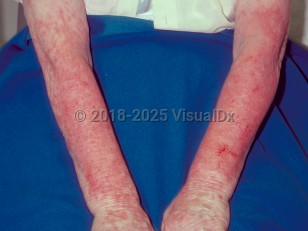Drug-induced phototoxicity results in a rash similar to sunburn. The rash is thought to result from a systemic drug (circulating in superficial dermal blood vessels) absorbing ultraviolet light (UVL) and releasing free radicals and reactive oxygen species, which damage or "burn" the skin in only those areas exposed to the UV source. All drugs that cause such a reaction absorb UV and/or visible radiation. The effects are dependent on both the dose of the drug and the amount of UVL that the person is exposed to.
In general, patients with a phototoxic drug eruption complain of burning.
Three types of clinical reactions can occur:
- Immediate / Mild – Immediate onset of erythema occurring approximately 30 minutes after UVL exposure. This reaction is associated with burning and pruritus but minimal edema. It usually lasts for 1-2 days after stopping UVL exposure.
- Immediate / Wheals – Immediate onset of transient wheals associated with burning. This reaction can occur with room light (non-UVL) and resolves rapidly after light exposure is stopped.
- Delayed / Severe – Onset is 8-24 hours after UVL exposure. This reaction is associated with dark erythema, edema, and hyperpigmentation. Blistering may occur with severe reactions. It usually lasts 2-4 days after UVL exposure is stopped, but in some instances, it may persist for months.
Drug-induced photoallergic reactions are allergic reactions due to UVL- induced alteration of a drug. They are dose independent and do not occur in all patients. Patients typically complain of itching rather than burning, and symptoms tend to be chronic. Common offenders include the following: sunscreens (oxybenzone [benzophenones, cinnamates-3]), fragrances (musk ambrette, sandalwood oil), topical antimicrobial agents (chlorhexidine, fenticlor, hexachlorophene), NSAIDs (diclofenac, ketoprofen, piroxicam, celecoxib), phenothiazines (chlorpromazine, promethazine), antiarrhythmics (quinidine), antifungals (griseofulvin), antimalarials (quinine), quinolones (enoxacin, lomefloxacin), sulphonylureas (glipizide), and sulfonamides.
Drug-induced photoallergic reactions manifest as red, scaling, pruritic (eczematous) papules and plaques in photodistributed areas (forehead, malar areas, sides of neck, and dorsum of the hands). This eruption is often pruritic and looks like chronic atopic dermatitis with a photodistribution.



 Patient Information for
Patient Information for 
